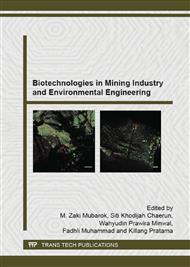p.222
p.226
p.230
p.234
p.238
p.243
p.247
p.251
p.255
Aspergillus niger PSSG8 Mediated Bioleaching of Monazite for the Recovery of Rare Earth and other Metal Constituents
Abstract:
Aspergillus niger PSSG8 is assisted bioleaching of monazite to recover the constituent metals were investigated. Bioleaching was carried out using Bromfield (BM1/10P & BM-P) and sucrose media (SM1/10P & SM-P) with different levels of Phosphate under rotary and stationary conditions. The growth of the A. niger PSSG8 significantly reduced the media pH to acidic. However, the media pH changed later in rotary shake flasks and were stable in roux bottles. A similar trend was observed for ORP. ORP increased as leaching progressed, but in rotary shake flasks ORP started decreasing after 15 days in Bromfield and 30 days in sucrose media. Fungal growth was maximum in SM when comparing to BM. The reduction and the omission of phosphate in both media did not significantly influence the culture parameters including the yield of biomass. ICP-AES analysis of leach liquor showed highest recovery of cerium (Ce) (1419 µg/L in BM-P) and thorium (Th) (182 µg/L in SM1/10P) in rotary conditions when comparing to the stationary conditions (229 µg/L Ce in BM 1/10P & 159 µg/L in SM-P). Reduction in the metal concentration was observed in the rotary shake flasks after 15 days of incubation. It was due to the biosorption of released metals by the fungal mycelium. Uranium was not detected in any of the media tested. SEM studies of the partially bioleached and control mineral particles show no changes in the surface features.
Info:
Periodical:
Pages:
238-242
Citation:
Online since:
November 2015
Authors:
Keywords:
Price:
Сopyright:
© 2015 Trans Tech Publications Ltd. All Rights Reserved
Share:
Citation:


